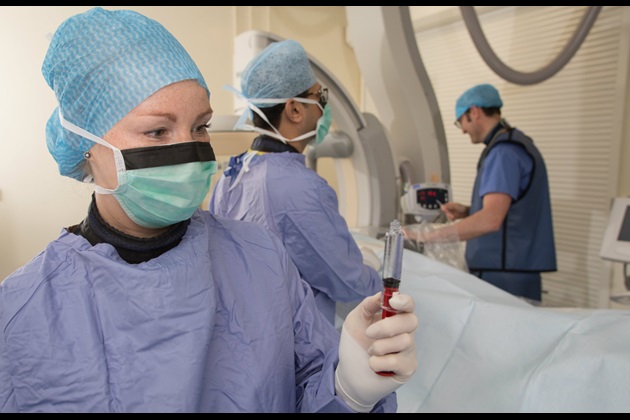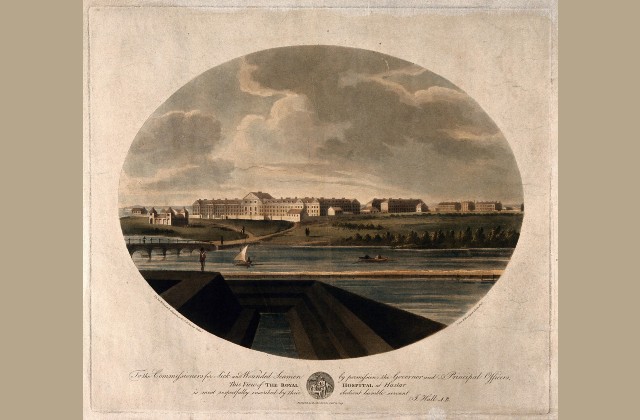Interventional radiology is a form of image-guided surgery that’s developing rapidly. Three RCN members describe their roles within the specialty and how rewarding they find them
Interventional radiology (IR) is not a branch of health care that features often among first-choice career options for registered nurses. In part, that may be due to lack of awareness. But for those who do find their way into jobs in IR, there may be no looking back. It can prove to be an area of nursing that is at once challenging, different and immensely satisfying.
At Leeds Teaching Hospitals NHS Trust, three RCN members and their colleagues are on a mission to promote the attractions of IR nursing to the wider profession.
Simon Gulliver, senior charge nurse in radiology theatres at the trust, began working in IR as a newly qualified nurse and almost by chance. “I stumbled upon it really,” he says. “Like many nurses, I’d never heard of interventional radiology, didn’t know what it was and came across it at the time of applying for posts.”
I went into it with an open mind and just loved it
If you are unfamiliar with IR, and it seems many are, it is a form of image-guided surgery. X-rays, ultrasound, CT and MRI scanners are used to guide equipment into areas of the body that can’t usually be reached by open surgery.
By making a small incision in the skin, a guidewire and catheter can be passed through blood vessels to the place where diagnosis or treatment is needed.
It’s an area that’s developing rapidly and it offers several advantages over conventional surgery. For example, it reduces the risk of infection; the patient is often awake throughout the procedure; and recovery times are reduced.
Extended roles
For nursing staff, IR enables them to care for acutely ill patients and apply their general nursing expertise, but also to develop and apply skills such as administration of conscious sedation, deployment of closure devices, venous line insertions and assisting in ablations procedures.
Good communication is essential, in part because patients are not routinely given general anaesthetic, but also to gain informed consent and sometimes in the aftermath of an unfavourable diagnosis.
In Leeds, IR nurses work in a number of specialties across radiology, including interventional ultrasound and interventional oncology. The IR team works across two sites, St James’s University Hospital and Leeds General Infirmary, and several nurses carry out specialist and extended roles.
Simon, for example, is a non-medical prescriber, which benefits the patient as well as the service. It allows him to provide better access to medicines such as pain relief before, during and after procedures, thereby releasing consultants so they can continue with procedures.
His senior charge nurse colleague Ian Medlicott is a vascular sonographer – someone trained to use ultrasound to produce images of patients’ veins and arteries.
Ian says the training was onerous but he’s now able to scan for conditions that include aortic aneurysms, carotid plaques and ischaemic limbs, as well as dialysis fistulas. He also undertakes vein mapping.
“I’m the first nurse in our radiology team who’s completed the ultrasound training,” he says. “I find it very rewarding and I’m proud to have completed the course.”
Common procedures in IR include:
- embolisation, where materials are used to block an affected vessel and stop bleeding
- endovascular aneurysm repairs, known as EVARs, which use stents to seal the aneurysm and restore normal blood flow through the aorta
- percutaneous tumour ablation, a relatively new method of treating tumours in kidneys, lungs, bones, the liver and the pancreas
- assessing fistulas for strictures or narrowings that could cause problems for patients on dialysis, and which are treated by angioplasty
- urology procedures such as nephrostomy, where a tube is inserted directly into the kidney to drain urine in the treatment of hydronephrosis
Nurses are crucial
The IR team sees and treats a wide range of patients with vascular and neurological conditions, as well as those who have been subject to trauma such as traffic accidents, where there may be internal bleeding.
The variety of procedures undertaken means the IR team works closely with many other specialties, including respiratory, urology, oncology and stroke. “And IR nurses are crucial to the whole department,” says Simon. “The service wouldn’t be able to function without them.”
As a department that crosses so many specialties, nurses from all backgrounds are able to use and develop their knowledge and skills in their roles within the IR team.
IR nurses are crucial to the whole department. The service wouldn’t be able to function without them
For IR nurse Tamsin Foster, becoming part of the IR team rekindled her enthusiasm at a time when she was beginning to doubt that nursing was the career for her. Like Simon, she didn’t know the IR department existed until she had to escort a patient there and became fascinated by the work undertaken.
“I’d always wanted to work in theatres but I didn’t like the fact that you couldn’t build that rapport with patients because they were mostly under general anaesthetic,” she says. “What I love about interventional radiology is, yes, it’s a type of surgery but you still get that little bit of rapport.”
Remarkable difference
The rapid improvement seen in some patients is particularly gratifying.
“You’ll have an acute stroke patient come in and carry out a thrombectomy – to remove the clot – and it’s amazing because when the patient arrives they’re symptomatic. And then, by the end of the procedure, it’s made such a remarkable difference to the patient’s symptoms. It’s almost unbelievable.”
Tamsin has worked in IR for two years and in that time has gone from being on the point of quitting nursing to loving it again. She’s acquiring new skills, is working in a specialty that is developing rapidly, and is part of a team that is supportive and highly professional but also enjoyable to work in.
“It’s a different type of nursing and I love it,” she says. “Don’t get me wrong, I do miss working on a ward and getting to know my patients, but this is so rewarding in a different way.
“It also has such a massive future. I just wish people knew more about it and got to know us a little better.”
It has such a massive future. I just wish people knew more about it
An RCN view
Suman Shresthsa, RCN Professional Lead for Acute, Emergency and Critical Care, says: “Interventional radiology is certainly a specialty that is growing, with the development of technology and new techniques, and often the patients undergoing IR procedures are complex and are acutely ill, with co-morbidities.
“Nurses are not only providing care in IR, but some are also performing procedures as advanced nurse practitioners in this field.
“This demonstrates how opportunities for nurses in clinical practice are evolving.”








